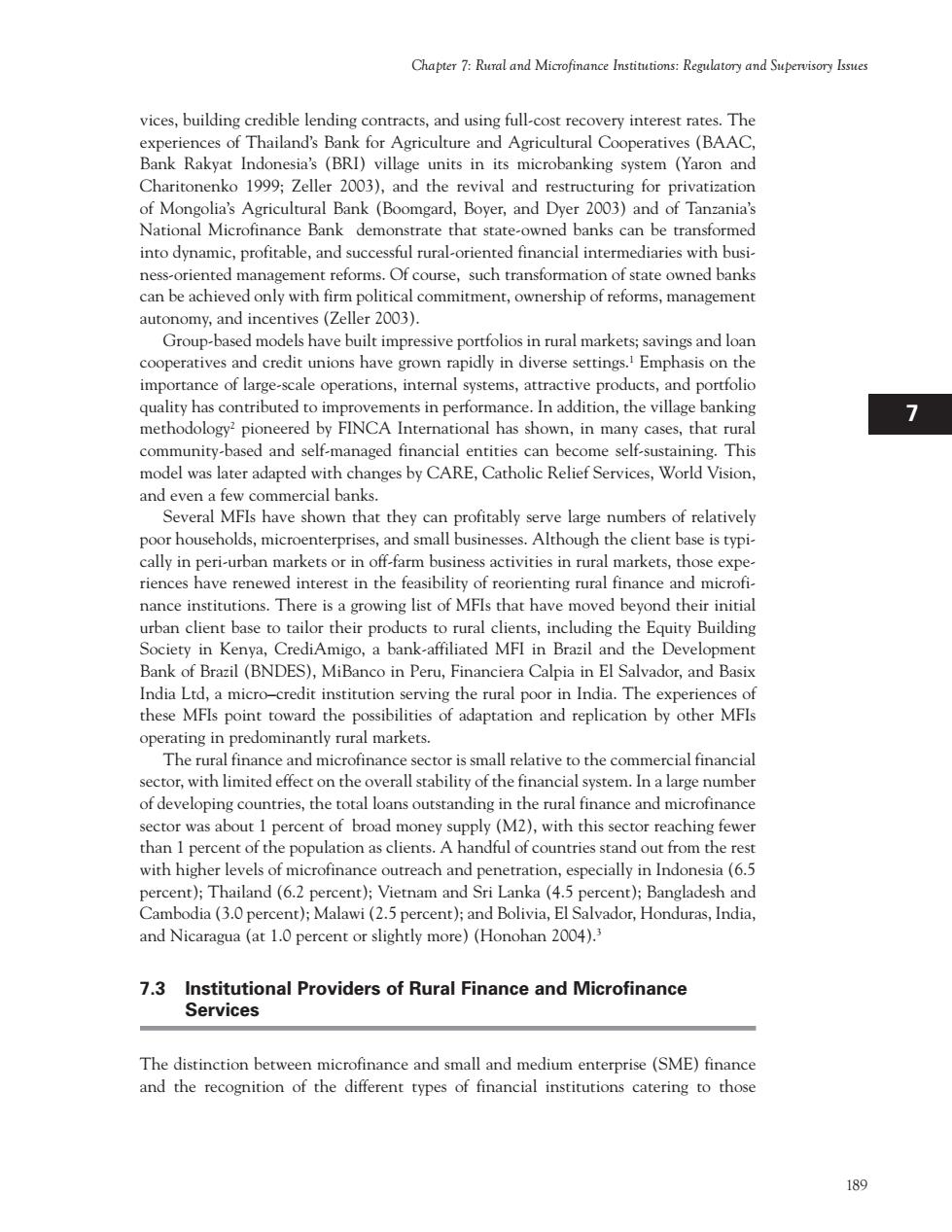正在加载图片...

Chapter 7:Rural and Microfinance Istittions:Regulatory and Supervisory Issues ces,buildine lendn cotracts,and using full-cost recovery interest rates.The experiences of Thailand's Bank for Agriculture and Agricultur kya t Ind a's(BRI) units in its microbanking system(Yaron and Charitoner ko 1999;Zeller 2003),and the revival and restructuring for privatization of Mongolia's Agricultural Bank(Boomgard,Boyer,and Dyer 2003)and of Tanzania's National Microfinance Bank demonstrate that state-owned banks can be transformed into dynamic,profitable,and successful rural-oriented financial intermediaries with busi- ness-oriented management reforms.Of course,such transformation of state owned banks can be achieved only with firm political commitment,ownership of reforms,management autonomy,and incentives(Zeller 2003). Group-based models have built impressive p ortfolios in rural markets gs and loan Emp 50I importance of large-scale operations,internal systems,attractive products,and portfolio quality has contributed to improvements in performance.In addition,the village banking methodology2 pioneered by FINCA International has shown,in many cases,that rura community-based and self-managed financial entities can become self-sustaining.This model was later adapted with changes by CARE,Catholic Relief Services,World Vision, and even a few commercial banks. Several MFIs have shown that they can profitably serve large numbers of relatively small busine s.Although the client base is typi ally in peri-uban marke ts or in arm sine activities in ru arkets,tho se exp riences have renewed interest in the feasibility of reorienting rural nance nance institutions.There is a growing list of MFIs that have moved beyond their initial urban client base to tailor their products to rural clients,including the Equity Building Society in Kenya,CrediAmigo,a bank-affiliated MFI in Brazil and the Development Bank of Brazil (BNDES),MiBanco in Peru,Financiera Calpia in El Salvador,and Basix India ltd.a micro-credit institution serving the rural poor in India.The experiences of these MFIs point toward the possibilities of adaptation and replication by other MFls pe ral markets The rur e and mi is small relative to the ial on the verall stability of the financia arge numbe feveloping coutries,the total loans outstanding in the rafinanceandm sector was about 1 percent of broad money supply (M2),with this sector reaching fewer than l percent of the population as clients.A handful of countries stand out from the rest with higher levels of microfinance outreach and penetration,especially in Indonesia(6.5 percent):Thailand(6.2 percent);Vietnam and Sri Lanka(4.5 percent);Bangladesh and Cambodia (3.0 percent):Malawi (2.5 percent):and Bolivia,El Salvador,Honduras,India and Nicaragua (at 1.0 7.3 Institutional Providers of Rural Finance and Microfinance Services The distinction betweer microfinance and small and medium enterprise(SME)finance and the recognition of the different types of financial institutions catering to those 189 189 Chapter 7: Rural and Microfinance Institutions: Regulatory and Supervisory Issues 1 I H G F E D C B A 12 11 10 9 8 7 6 5 4 3 2 vices, building credible lending contracts, and using full-cost recovery interest rates. The experiences of Thailand’s Bank for Agriculture and Agricultural Cooperatives (BAAC, Bank Rakyat Indonesia’s (BRI) village units in its microbanking system (Yaron and Charitonenko 1999; Zeller 2003), and the revival and restructuring for privatization of Mongolia’s Agricultural Bank (Boomgard, Boyer, and Dyer 2003) and of Tanzania’s National Microfinance Bank demonstrate that state-owned banks can be transformed into dynamic, profitable, and successful rural-oriented financial intermediaries with business-oriented management reforms. Of course, such transformation of state owned banks can be achieved only with firm political commitment, ownership of reforms, management autonomy, and incentives (Zeller 2003). Group-based models have built impressive portfolios in rural markets; savings and loan cooperatives and credit unions have grown rapidly in diverse settings.1 Emphasis on the importance of large-scale operations, internal systems, attractive products, and portfolio quality has contributed to improvements in performance. In addition, the village banking methodology2 pioneered by FINCA International has shown, in many cases, that rural community-based and self-managed financial entities can become self-sustaining. This model was later adapted with changes by CARE, Catholic Relief Services, World Vision, and even a few commercial banks. Several MFIs have shown that they can profitably serve large numbers of relatively poor households, microenterprises, and small businesses. Although the client base is typically in peri-urban markets or in off-farm business activities in rural markets, those experiences have renewed interest in the feasibility of reorienting rural finance and microfinance institutions. There is a growing list of MFIs that have moved beyond their initial urban client base to tailor their products to rural clients, including the Equity Building Society in Kenya, CrediAmigo, a bank-affiliated MFI in Brazil and the Development Bank of Brazil (BNDES), MiBanco in Peru, Financiera Calpia in El Salvador, and Basix India Ltd, a micro–credit institution serving the rural poor in India. The experiences of these MFIs point toward the possibilities of adaptation and replication by other MFIs operating in predominantly rural markets. The rural finance and microfinance sector is small relative to the commercial financial sector, with limited effect on the overall stability of the financial system. In a large number of developing countries, the total loans outstanding in the rural finance and microfinance sector was about 1 percent of broad money supply (M2), with this sector reaching fewer than 1 percent of the population as clients. A handful of countries stand out from the rest with higher levels of microfinance outreach and penetration, especially in Indonesia (6.5 percent); Thailand (6.2 percent); Vietnam and Sri Lanka (4.5 percent); Bangladesh and Cambodia (3.0 percent); Malawi (2.5 percent); and Bolivia, El Salvador, Honduras, India, and Nicaragua (at 1.0 percent or slightly more) (Honohan 2004).3 7.3 Institutional Providers of Rural Finance and Microfinance Services The distinction between microfinance and small and medium enterprise (SME) finance and the recognition of the different types of financial institutions catering to those